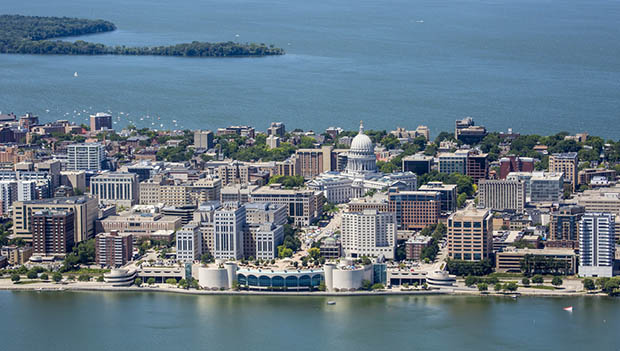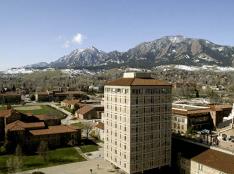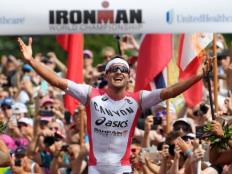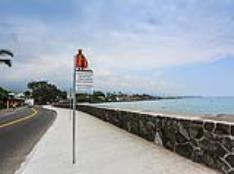
IRONMAN Wisconsin—the name alone doesn't conjure up images of howling winds across barren lava fields or iconic open water swims amongst sea turtles. It's pretty under the radar as far as triathlons go, yet surprisingly sneaky (and surprisingly tough). Sure, all iron-distance triathlons are hard and present their own unique challenges to the participants, but IRONMAN Wisconsin has tons of charm and unique characteristics that truly make for a memorable race experience.
With several Athletes' Choice Awards to its name, including "Overall Satisfaction," "Best Overall Run" and "Best Post-Race Celebration," IMWI is quickly becoming a must-do destination race for triathletes across the globe.
Here, we breakdown the swim, bike and run courses, give you an overview of the surrounding attractions and eats, and outline a little something for spectators, too. This challenging late-season race with small-town charm just might be the triathlon experience you've been looking for.
The Swim
The IRONMAN Wisconsin swim is something to behold. Athletes start in Lake Monoma (rolling start) in downtown Madison, and the spectators are what make this leg of the race memorable. The Monona Terrace—a multi-level waterside structure—gives spectators a bird's-eye view of the swim course. The course is one counter-clockwise loop, so athletes will see and hear thousands of cheering supporters along their right shoulder as the cannon goes off.
The water temperature usually hovers around 70 degrees Fahrenheit, and like all IRONMAN events, athletes who wear a wetsuit when water temperatures are between 76.2 and 83.8 degrees won't be eligible for a Kona slot or age-group awards. Depending on the wind, the water can be choppy, but overall it's a pretty safe and straightforward course.
The transition area is inside the Monona Terrace, where athletes run up the parking helix after the swim to T1 (and makes for a nice warm-up before the bike).
The Bike
After changing in T1, athletes then descend down the helix and onto the bike course. The course looks like a frying pan on paper—athletes ride 16 miles away from Madison, complete two 40-mile loops through rural Dane County then return back into town on the same 16-mile stretch.
The IRONMAN Wisconsin bike course is notoriously difficult. It's a constant up-and-down, featuring challenging hills that include the famous "Barlow Hill," for a total elevation gain of 4,120 feet (yes, you read that right). Plus, winds can be brutal and highly unpredictable—you might face headwinds both ways with some crosswind gusts to add to the fun.
Pacing is important here, and it's not uncommon to see athletes opting to walk their bikes up some of the hills instead of grinding up them and wasting valuable energy they'll need later on in the race. Hydrate, take in your calories and leave something in the tank for the marathon. Discipline is key—race your race, not someone else's.
The Run
As mentioned above, the IRONMAN Wisconsin run course was voted "Best Overall Run" in 2017. Thousands of cheering spectators line the run course, which is a welcomed jolt of energy after a difficult 112 miles on the bike. Despite the support though, the marathon isn't a breeze. Like the bike course, the run leg is hilly and includes a total elevation gain of 946 feet.
Spectators are especially dense along four major sections of the run—Campy Randall Stadium, State Street, the University of Wisconsin campus and downtown Madison—so runners have only a handful of stretches without spectator encouragement.
Spectators
Multiple loops on the bike and run course, as well as the spectator access at the Monona Terrace, makes IRONMAN Wisconsin super spectator friendly. Especially on the run course, you're usually only a few blocks away from the athletes at all times, giving you plenty of opportunities to cheer late in the race. Parking is available at the Alliant Energy Center (only $6 for the day), with spectator shuttle buses running from 4 a.m. to 1 a.m. on race day.
If you want to see an athlete on the bike besides descending down the helix and riding away from town, head out to Verona and post up to cheer on one of the steeper hills. This is a great opportunity to give an athlete a little moral boost and much needed words of encouragement.
The finish line is along the 200 block of Martin Luther King Jr. Boulevard in downtown Madison and is easily accessible for spectators.
Note that the weather in Madison on race day can vary greatly, so be sure to pack for the conditions at hand (this goes for athletes as well).
Nearby Attractions
We imagine your spectators and race Sherpas will have their hands full cheering for you on race day, but Madison and the surrounding area has plenty of amenities and attractions for non-triathletes (or post-race recovering participants).
Take a walk (active recovery, anyone?) through Henry Vilas Zoo, the Olbrich Botanical Gardens or the Chazen Museum of Art, or enjoy one of Madison's food or pub tours. There's plenty of delicious cuisine within walking distance from the major hotels, including The Old Fashioned, Naples 15, Graze Restaurant, Heritage Tavern and more.
Be sure to make a reservation weeks in advance—these restaurants are bombarded by hungry IRONMAN triathletes and their supporters all weekend.
Learn more about and register for IRONMAN Wisconsin
READ THIS NEXT: Great Destination Triathlons Around the World








Discuss This Article